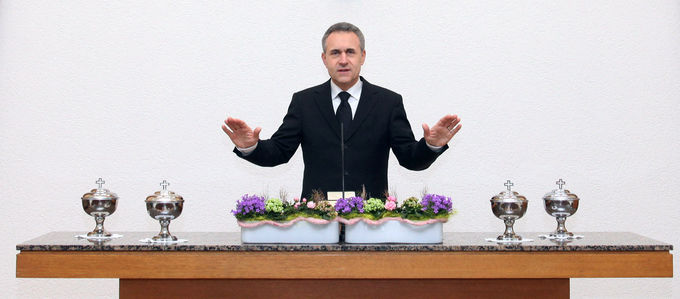The closing benediction: God is with us in life

Every divine service concludes with a solemn moment: the Priest pronounces the blessing of the triune God—Father, Son, and Holy Spirit—on the congregation to accompany them in everyday life. What an assurance!
The liturgy of the divine service provides that the divine service is framed by the Trinitarian opening formula and the Trinitarian closing benediction. At the beginning of the service, the formula expresses the presence of the triune God: “In the name of God, the Father, the Son, and the Holy Spirit.” This indicates that the proclamation of the word of God can begin. The Priest makes himself and the congregation aware that this occurs in the name of the Most High.
At the end of the divine service, the congregation receives the assurance that God is with us in life, in our everyday lives: “The grace of the Lord Jesus Christ, and the love of God, and the communion of the Holy Spirit be with you all!” (2 Corinthians 13: 14). Anyone who is dismissed like this need have no doubt as to whether there is a loving God or not. This closing benediction makes clear: God is your God; He is gracious and loves you; He is with you! Those who believe can rely on the grace of God, feel secure in the love of God, and be assured of the guidance of the Holy Spirit. They are assured of God’s saving and preserving presence in their lives, which helps them to model their lives on the gospel.
Blessed with a solemn gesture
The Priest pronounces the blessing with both arms raised and extended over the congregation. He holds eye contact. It is a dignified and solemn moment. To the final amen of the preacher, the congregation responds with its amen. Every single believer asserts this. The three-fold amen, sung by the entire congregation, confirms this knowledge: Amen – Amen – Amen, it is so.
A special kind of declaration of reconciliation
It is not a coincidence that Paul’s words from 2 Corinthians 13 were chosen. Of course it refers to the Trinity, an important biblical statement for the Christian faith. Of course this final greeting is ideal as a closing benediction. Yet something else is important too: in the verses preceding it, the Apostle exhorts the congregation of that time to mend their ways and agree with one another and live in peace. The closing benediction is therefore also a declaration of reconciliation in two respects: God is reconciled with us, and we want to be reconciled among each other as well. If a divine service ends in such a way and the proclamation of God’s will has managed to achieve this two-fold reconciliation, then everything is fine. The believer is part of the Lord’s large fellowship, a member on His body, a member of His church, and can place his own desires and ideas under the will of the Almighty. Those who receive grace from Jesus can themselves show mercy. Those who love God can love their neighbour. Those who walk in the fellowship of the Holy Spirit will know and see what is essential in life.
Liturgy is the worship of God
The liturgy gives structure to the divine service. Not only the content acquires meaning, but also the outer form. After all, this is about God and His teaching and His presence. Divine service is the anticipated experience of the future fellowship with the triune God and the central event of congregational life. The liturgy is there to structure the course of a divine service, from opening hymn to closing hymn. That is why it is important that the officiating ministers celebrate the liturgy properly. The established order is to prevent arbitrariness from arising in the celebration of divine service, and thereby strengthen and raise the awareness of the unity of the Church. In the order of the liturgy of the New Apostolic Church it says: “The liturgical texts are binding, and their wording must not be changed.”




